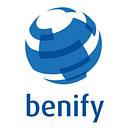Here’s How to Help Employees Understand the True Value of Their Compensation
Salary is important but it doesn’t provide a complete picture of an employee’s total compensation, nor can it be used to gauge employee satisfaction.
A Harvard Business Review survey of over 2,000 American professionals at a variety of pay levels and industries revealed that 9 out of 10 employees would be willing to trade a percentage of their lifetime earnings to do more meaningful work.
In addition to a desire to do more meaningful work, many people are discovering that it’s more important to them to have a job that supports their lifestyle rather than simply collect a bigger salary.
Flexibility — being able to leave the office early to pick up the kids or the ability to work from home when needed — has become increasingly important, as have employee benefits and having an understanding of one’s own finances (also known as financial wellness).
Knowing Your True Worth
Benify surveyed over 20,000 employees and HR leaders across a variety of industries about benefits, rewards, personal finances, and employee engagement for its 2018 Employee Happiness Index. The results revealed a strong link between benefits satisfaction and workplace engagement.
The research also showed that employees at organisations with a benefits strategy — that is, companies who know their employees’ concerns and making sure that any benefits offering is aligned with the company’s broader business goals — are:
• 20% more satisfied with their benefits
• 19% more convinced their benefits are better than other workplaces
• 14% closer to their employer’s brand
The survey also revealed that a staggering 80% of employees underestimated their total compensation. Without the knowledge of their total compensation, this means that employees are missing out on a large portion of their compensation. As one Forbes article explains, benefits can play a significant role in the larger financial picture and explains how, for example, Google’s free breakfast, lunch, and dinner can add up to over $10k on top of an employee’s salary.
Show Me the Money
So, how exactly do employers help employees understand their full investment? By providing employees with a clear visualisation in the form of a so-called Total Reward Statement.
In Benify’s award-winning employee portal, employees are presented with an illustration showing the value of their employer’s total investment. An employee’s Total Reward Statement gives the individual a monetary breakdown of their salary, pension, insurances, and other benefits paid to them as part of their compensation, which is then presented as a graph providing a clear overview of the components adding up to their total compensation.
Any changes to an employee’s compensation, such as enrolment into new benefits, are updated in real-time. Since employees can access their Total Reward Statement through the portal anywhere, anytime, via the Benify app, they’re always able to see their true value.
An employee’s Total Reward Statement is, of course, personalised — based on the individual’s own employment details — and personalisation is key to engagement.
Making Employees Aware
A company’s greatest benefits offering means very little, however, if employees are unaware of them. That is why effective communication is essential especially when you have a workforce based in multiple locations and countries, or when you have blue-collar employees who are not stationed in front of a computer. This is where targeted communication comes in.
With targeted communication, the content of a message is adapted to a specific audience and that the message is only sent to the individual or group(s) concerned. For example, with the use of filters, emails, push notifications, or messages can be sent to all people with access to a particular employee benefit, all people in a specific age category, or all people who work within a particular region.
Today, we see baby boomers, Generation X, millennials, and Generation Z all working together, each with their own communication preferences. Again, personalisation is key to engagement, and targeted communication allows organisations to engage their employees personally and more effectively.
How does your organisation help employees understand their true value?
